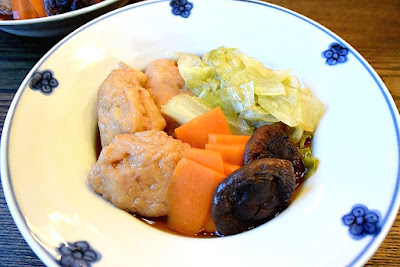This resembles a
nabe hot pot but is cooked in a stronger broth. Soft and fluffy
tsumire fish dumplings crumble in your mouth, while lettuce gives some crispiness. As with any item made with
surimi ground fish paste, these dumplings by themselves contain a relatively high amount of sodium, but the sodium is released into the broth while simmering, and you can comfortably enjoy the gentle taste
tsumire offers -- one of the great advantages of
nimono simmered dishes, where the broth is often left behind in the pot or untouched in bowls.
196 calories (1/2 of recipe); 12.6 g protein; 8.2 g fat; 14.6 g carbohydrate; 13.0 g net carbs; 250 mg sodium (with 50% reduced-sodium soy sauce); 79 mg cholesterol; 1.6 g fiber







